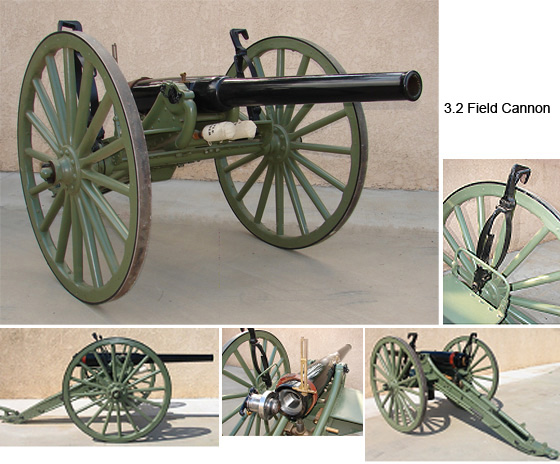Artillery Cannons & Mortars
When the Civil War started, bronze-barreled smooth bore cannon dominated the Union’s Artillery. Most guns were firing 6-pound ammunition on a relatively low trajectory and Howitzers capable of lofting 12-pound projectiles on a arcing trajectory.

The introduction of rifled guns during the Civil War greatly improved the accuracy of our cannon warfare. The Parrot rifle was accurate and because it's barrel was made of cast iron rather than costly bronze it was inexpensive to manufacture. A parrot rifle could hit a target at 2500 yards, about twice the range of a smooth bore gun.

The next improvement for the U.S. cannon, which happened after the Civil War, was changing from muzzle (front) loading to breech (rear) loading cannons. One of the breech-loading field cannons adopted for the United States services was the 3.2-inch field rifle.
Museum Examples
3.2 Field cannon – U.S. Model 1890
The newly designed 1885 3.2 Field Gun, unlike its predecessor the 3" Ordinance rifle (a front muzzle loading gun), was developed to load from the rear. This enabled the crew to load and fire at a more rapid rate. Like most field guns, improvements were made along the way resulting in 3 models, 1885, 1890, & 1897. Its Indian War Era service record includes Wounded Knee in 1890. This gun was used in the Spanish American War battle at Santiago de Cuba and the Philippine Insurrection.
3.2 Field Gun Ballistics Information
These breech loading unique weapons were the 1st to use dampening recoil brake systems throwing the gun forward and back, giving it the nickname "grasshopper". Barrel length is 88" long with a 3.2" bore giving it an accuracy range of 5000 yards.
3" Mountain Gun
Only 4 of these 3" breech loading mountain guns are on record as being purchased by the U.S. Army in the early 1890's. It was to see limited use in the Spanish-American War. The “Astor battery” used these guns in the Philippine Insurrection of 1899, making this a very rare U.S. Artillery specimen.
3" Mountain Gun Ballistics Information
The projectiles used for this gun were: (large image) a common shell (6.3 oz. fine-grain powder) percussion fuse, #2 a shrapnel shell loaded with 160 steel balls packed in sulfur with a timed fuse to explode directly above the target, and #3 a canister with 125 lead balls used for short range (like a shotgun). They weighed approximately 12 lbs. each. The 3" caliber gun has a maximum range of 4000 yards. It can be transported by pack mule, as described with the 1.65" mountain gun.
Hotchkiss 1.65 Mountain Gun
The U.S. military forces around 1881 adopted the Hotchkiss two-pounder mountain gun. Primarily used for western campaigns due to their lightweight and portability. They were generally broken down onto a mule pack by removing the barrel, wheels and carriage separately. The barrel length is 46" long weighing 121 lbs. the wheels each 66 lbs. and the carriage 220 lbs., plus the standard load of 56 rounds of ammunition. Best known use of these cannons was deployment in the Nez Pierce war of 1877 and at the Wounded Knee battle in 1890.
Mountain Gun Ballistics Information
Two types of projectiles were issued, common shell with a percussion fuse and canister. The caliber was 1.65 in. Maximum range was about 4000 yds. The slow moving projectile had only a velocity of 591 ft per second at maximum range but an initial velocity of 1298 ft per second.
Mortars
 Mortars have existed for hundreds of years, first finding usage in siege warfare. However, these weapons were large and heavy, and could not be easily transported. Simply made, these weapons were no more than iron bowls reminiscent of the kitchen and apothecary mortars from where they drew their name. Mortars, whether chambered or not, are a very simple form of ordnance, intended for lobbing heavy projectiles at a high elevation, typically referred to as "indirect" or "plunging" fire. An early transportable mortar was invented by Baron Menno van Coehorn (Siege of Grave, 1674). Coehorn mortars, of approximately 180 lbs weight, were used by both sides during the Civil War. Mortars were typically muzzle loading until 1890 when the first breech loading 3.6” mortar was developed.
Mortars have existed for hundreds of years, first finding usage in siege warfare. However, these weapons were large and heavy, and could not be easily transported. Simply made, these weapons were no more than iron bowls reminiscent of the kitchen and apothecary mortars from where they drew their name. Mortars, whether chambered or not, are a very simple form of ordnance, intended for lobbing heavy projectiles at a high elevation, typically referred to as "indirect" or "plunging" fire. An early transportable mortar was invented by Baron Menno van Coehorn (Siege of Grave, 1674). Coehorn mortars, of approximately 180 lbs weight, were used by both sides during the Civil War. Mortars were typically muzzle loading until 1890 when the first breech loading 3.6” mortar was developed.
3.6" Breech Loading Mortar
This weapon listed on the 1899 ordnance report is a 3.6-inch breech loading mortar, Model of 1890. This was a rare artillery piece (only 76 were made) and were mainly used for training but first used in combat in Cuba during the Spanish American War of 1898.

Field Mortar Ballistics Information
Fired from a wooden platform the weapon could hurl either a 20 pound explosive common shell or a time fused shrapnel shell to the maximum range of 3450 yards.














